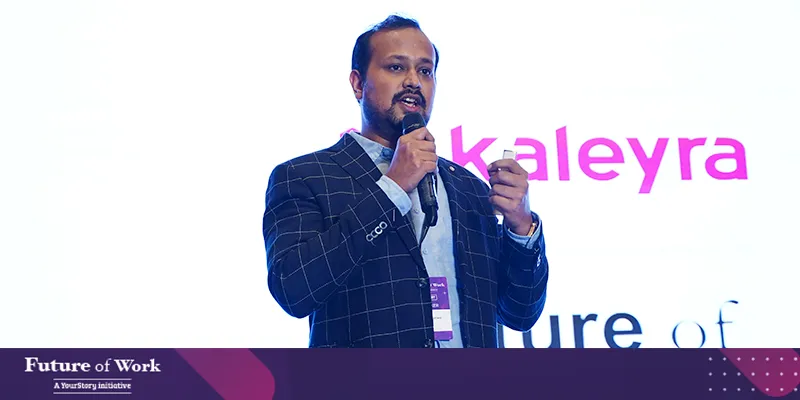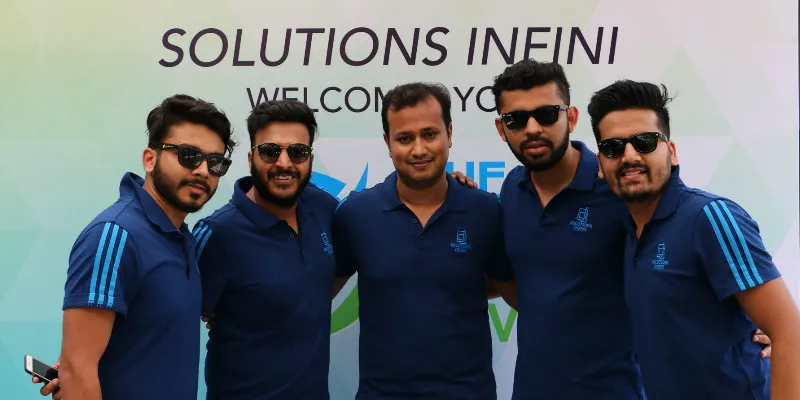Future of Work 2020: Kaleyra’s Ashish Agarwal explains how to take a product company to IPO
At YourStory’s Future of Work conference, Ashish shared how a customer-friendly approach and aggressive sales tactics helped Kaleyra take its CPaaS product to IPO.
When they were in college, Ashish Agarwal and Aniketh Jain worked on a project for sending messages to parents about their children’s exam results. They realised the same solution could have a much bigger impact. It could be used by large-scale enterprises and small businesses to send SMSs to their customers.
To capitalise on this idea, they started Solutions Infini in 2009 with Rs 4 lakh bootstrapped capital. It quickly grew big and started managing cloud communication on multi-channel platforms including messaging, voice, email, and APIs. It also started providing services such as long and short codes, IVR, click-to-call, call conferencing, call masking, and toll-free solutions.
Through its Communications Platform as a Service (CPaaS) product, Solutions Infini successfully delivered messages in more than 190 countries and acquired strong operator connections in over 20 countries, including Bangladesh, Sri Lanka, Nepal, and other South Asian countries.

Ashish Agarwal, CTO, Kaleyra
In 2016, Italian IT and telecom services provider Ubiquity met with Solutions Infini. In 2018, they merged to form Kaleyra.
At the third edition of YourStory’s Future of Work, India’s largest product-tech-design conference, Ashish Agarwal, CTO, Kaleyra, explained how the company grew so rapidly:
“Our product and tech were completely driven by sales and customers. Customers giving us feedback was a good situation that helped us improve our product. Companies don’t always take feedback. Instead, they keep building products.”
Ashish recounted how his sales teams were so aggressive that they promised customers CPaaS product offerings that Kaleyra hadn’t built yet. The sales teams would then ask Kaleyra’s developers to build it.
In November 2019, Kaleyra announced its official listing on the New York Stock Exchange (NYSE). Its shares began trading on the NYSE under the Ticker Symbol ‘KLR’ on November 26, 2019.
Through a tie-up with Gig Capital Inc, Kaleyra transitioned into the US capital markets as a public company. The listing on NYSE allowed it to further strengthen its capital structure and capabilities to deliver advanced CPaaS solutions on a global scale.
Its sales strategy was one reason Kaleyra and its CPaaS product were able to go the IPO way. The company’s revenue stood at about Rs 693.6 crore before it became a listed company. Its impressive clientele comprised Amazon, Ola, Flipkart, AirAsia, Zomato, Cure.fit, Practo, and more.
Another reason that helped Kaleyra on the road to IPO was its proactive approach. Ashish said at the Future of Work 2020 that the company was proactive and not reactive in the way it solved the problems of its clients.
“Managing large infrastructure means you deal with a lot of variables and things can easily go wrong. We brought in DevOps as a culture in our organisation and gave them additional responsibilities. They had to be proactive and start jumping in to solve problems before clients reached out for help. This also helped our teams collaborate better,” he said.

The Solutions Infini team
Customer-friendly approach
After a point, Ashish and Aniketh realised they were stuck. Kaleyra was too busy solving problems on its existing infrastructure. It wasn’t building a lot of new solutions for customers.
The company and its CPaaS solutions were at a bottleneck. A potential client also told Kaleyra its APIs were not fast enough. Ashish was shocked, and met the client himself. The client showed Ashish a few tools that proved Kaleyra’s solution was among the slowest performing options available.
“We had to do something about it and we started examining where we were going wrong. We broke down our entire platform to improve individual parameters. Addressing these smaller parts proved hugely beneficial. We were able to reach 1,000x improvement on our platform, on an overall basis,” he said at the event.
This improvement allowed Kaleyra to approach new clients with confidence and strengthen customer relationships. Its decoupled architecture also played a critical role in boosting productivity. By bringing in a microservice concept and breaking modules into different services, the company did not have to run through everything to address a variable.
Ashish says Kaleyra also started monitoring data metrics closely. “Even now, we have at least 10 screens showing the metrics that we are monitoring, and we are constantly looking to improve them,” he said.

Aniketh Jain, General Manager for Global Enterprise Business, Kaleyra
Ashish’s and Aniketh’s customer-friendly approach to business was perhaps what attracted Ubiquity to Solutions Infini. In a previous interaction with YourStory, Aniketh had said:
“Considering Ubiquity was a strong player with respect to fintech services in Europe, they understood the scale at which India was growing in terms of technology and functional growth. They found us when they decided to look out for collaborating with Indian companies. With the strong presence of Solutions Infini in the industry and customer-friendly applications, we decided to take the company ahead to the next level by entering the European markets.”
Now, post IPO, Ashish and Aniketh plan to expand their product portfolio and capture a bigger share of the cloud communication enterprise market.
“The customer-focussed strategy has helped us scale our products and revenue. We have witnessed tremendous growth in the last decade. The public listing will further accelerate our growth and build up our capacity to deliver game-changing CPaaS solutions,” Ashish said.
Today, the company’s proprietary cloud communication platform is sending out more than 24 billion messages and over one billion voice calls per year.
(Edited by Javed Gaihlot)
A big shout out to our Future of Work 2020 Sponsors: Alibaba Cloud, Larksuite, Vodafone Idea Limited, Gojek, Adobe, Udaan, Pocket Aces, Junglee Games, Sharechat, Open, VestaSpace Technology, Maharashtra State Innovation Society, Kristal.AI and GetToWork; and our Knowledge Partner: Ascend Harvard Business Review.










